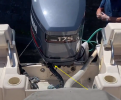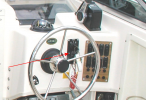Mine usually takes 4 tries to start up from cold, fully choked, but when it starts it idles at a good speed. If run for 30 min and then shut the motor for 30min-1 hour, my next start will take 10 tries. During those 10 tries, the motor never really turns over. Just wheezes until one magical try gets it to start, but if I don't give it gas at that point, it's idling so slow that it will stall.
Just for reference, I was offshore on Saturday fishing. I shut the motor for at least an hour while drifting. The motor did not want to start when I tried to get back home. As usual, trying 6 or 7 times, pulling choke, pushing choke back in, eventually got it going.



